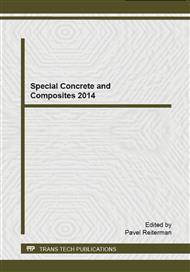p.104
p.110
p.116
p.122
p.128
p.132
p.138
p.143
p.148
Monitoring of Self Compacting Concrete Characteristics Development
Abstract:
The paper presents obtained results of self-compacting concretes with various compositions with focus on basic characteristics development. Firstly the fresh concrete properties are summed and self-compactness classes are categorised and subsequently the values of compressive strength, static and dynamic modulus of elasticity of hardened concretes are compared. All the stated parameters were monitored during different ages of the concrete and therefore they provide a view of its development in time. With still enlarging scale of concrete types and development of their application it is necessary to monitor common parameters which due to the application of new concepts in raw material compositions and use of higher amounts of additives may notably differ compared to applied orthodox concrete parameters.
Info:
Periodical:
Pages:
128-131
Citation:
Online since:
October 2014
Authors:
Price:
Сopyright:
© 2014 Trans Tech Publications Ltd. All Rights Reserved
Share:
Citation:


